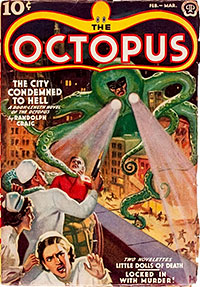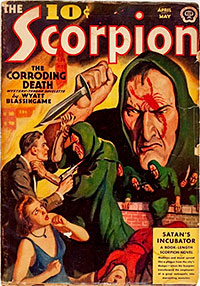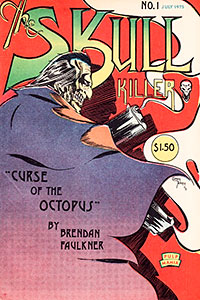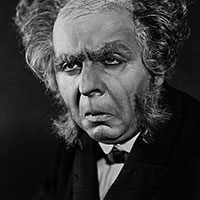 Pulps have their share of bizarre pulp heroes. But perhaps the strangest is The Skull Killer.
Pulps have their share of bizarre pulp heroes. But perhaps the strangest is The Skull Killer.
Never heard of him? Well, he didn’t star in his own pulp series, but was the hero in a pair of “villain pulps” where the villains were the stars: The Octopus and The Scorpion.
While the Skull Killer was clearly inspired by The Spider, he takes it further by having two other identities. He is rich playboy Jeffrey Fairchild, son of a doctor who had attended medical school but never practices medicine. But his next identity is that of kindly old Dr. Skull, who works in the city slums. A white wig and makeup completes his disguise. His final identity is that of The Skull Killer, a relentless vigilante who stamps the forehead of criminals he kills with a skull stamp (sound familiar?). However, it doesn’t seem as though the Skull Killer has any kind of consistent disguise.
Another character is Carol Endicott, a nurse hired to take care of Jeffrey’s crippled younger brother as well as working for Dr. Skull. She is not aware that Jeffrey is also Dr. Skull, much less the Skull Killer. But she might start connecting the dots after meeting the Skull Killer in disguise.
The Octopus came out in February/March 1939, several years after Popular’s last attempt at a villain pulp: Dr. Yen Sin. Because The Octopus was marked as Vol. 1, No. 4, speculation on what was Nos. 1-3 ran wild. One idea was the numbering picked up from Dr. Yen Sin, which is unlikely. The numbering was due to using a previous second-class postage registration (this was a common practice in the comic-book world of the time as well). Now it seems that the previous issues were The Western Raider, a western hero pulp edited by Ejler & Edith Jakobson. The Octopus lasted only that one issue, replaced by The Scorpion in April/May 1939. Using the same house name of Randolph Craig, it’s clear that The Scorpion was just the next Octopus story with the character renamed.
 Authorship of the stories was also debated. Norvell Page, author of The Spider, was always credited with writing both stories. But a pay record was found in the Popular Publications archives which shows Ejler & Edith Jakobsson being paid for The Octopus. So the idea now is that they wrote it, Norvell revised it, then wrote the second story. The Jakobsons also wrote a short-lived character, The Bleeder, from Dime Detective. Altus Press will soon be coming out with a complete reprint of stories.
Authorship of the stories was also debated. Norvell Page, author of The Spider, was always credited with writing both stories. But a pay record was found in the Popular Publications archives which shows Ejler & Edith Jakobsson being paid for The Octopus. So the idea now is that they wrote it, Norvell revised it, then wrote the second story. The Jakobsons also wrote a short-lived character, The Bleeder, from Dime Detective. Altus Press will soon be coming out with a complete reprint of stories.
In the first story, The Octopus is a bizarre weird-menace villain who seems half-man/half-octopus, with tentacles around his shoulder. He leads a sinister group of thugs, and turns people into crazed zombies who attacked everyone else, marked by their purple eyes. At the end, it seems that the Skull Killer bumps him off, but we are promised a return.
Instead, the second story gives us The Scorpion now creating purple-eyed crazies. The Scorpion is an ordinary man but still a sinister weird-menace foe, with a scorpion tattooed across his face. At the end of the story, he is also defeated, but we are promised more. But none appeared.
Comic books
In 1975, a group calling themselves Pulp Mania put out a comic starring The Skull Killer. They thought the copyright had lapsed. I guess they weren’t involved in pulp fandom, otherwise they would have known that wasn’t the case. This comic was a direct sequel to The Octopus, with a return match with The Octopus, who is finally killed. However, I don’t know if they had read the original story, or just a synopsis, as they made changes to the characters that made the whole story more Spider-like.
 The Skull Killer now dressing up in a bizarre disguise, Carol seems involved with the action and may know of the triple identities. New characters added are Norvell Quinn, former racketeer who helps the Skull Killer, and Syn, who appears to be a Sikh. These two characters seem inspired by the Spider’s associates Jackson and Rama Singh, and Carol seems cast more in the mode of Nita Van Sloan.
The Skull Killer now dressing up in a bizarre disguise, Carol seems involved with the action and may know of the triple identities. New characters added are Norvell Quinn, former racketeer who helps the Skull Killer, and Syn, who appears to be a Sikh. These two characters seem inspired by the Spider’s associates Jackson and Rama Singh, and Carol seems cast more in the mode of Nita Van Sloan.
The comic is a bit strange. It’s not a standard size being a little larger; the cover uses the same type of paper as the rest. It’s mainly black and white, with only a few pages in limited color. The writer is Brendan Faulkner, who seems to have been a writer-director to a few low-budget horror movies in the coming decades. The artist is Gary Terry, who seems to have had a long career as a storyboard artist but little comic-book work.
We were promised a second issue with the Skull Killer going up against Nazis, which never happened. Who knows what happened? I never even knew about this comic until recently. There is a blog that has reprinted the comic online.
At Moonstone during their “Return of the Originals” effort that would have included characters licensed from Popular’s successor, there were plans for Skull Killer stories. But nothing was done apart from a page in their overview comic of the line. Then Moonstone lost the license to use the Popular characters, so we’ll probably never see new comic stories. Heck, who knows if we will ever see new Skull Killer prose stories?
The two pulps were reprinted by Robert Weinberg in his Pulp Classics series (#11 and 12). Girasol did pulp facsimiles of them. Baen reprinted the Octopus in their first Spider reprint. I had hoped they would include the Scorpion in their next one, but it didn’t happen. What I would love to see is a reprint of the two in a single volume, like the old Ace Double format with the stories back to back with the covers. Including a good article covering the research into the two stories would be great. Probably never happen.




Back in the 70’s I was collecting Underground Comics and I had a copy of The Skull Killer back then. Long gone along with all my copies of Zap Comics, etc.
The check to Ejler & Edith Jakobsson was for $25. Likely they did the conversion from Octopus to Scorpion for the second novel. A check to Page hasn’t been found, but it is his writing style.
I recalled reading an article about this, but don’t think the amount was noted, or which work it was for.
The implication was that they wrote the Octopus, with re-writes by Page.
But then, this is part of the reason I’d love to see a new “double novel” reprint of the two that would include all this research on these two works so things like authorship, revision, et al, can come out.